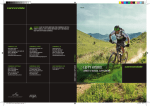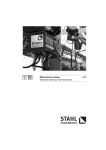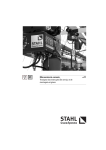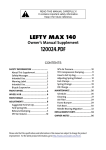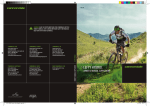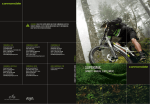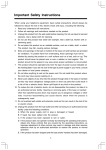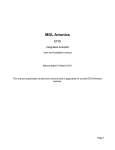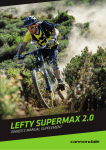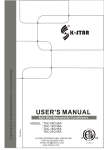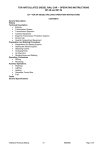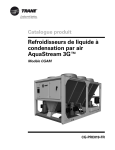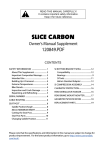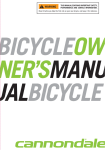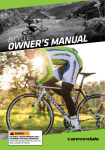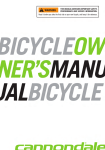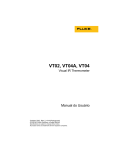Download LEFTY SPEED FOX RLC 110mm - eighty
Transcript
READ THIS MANUAL CAREFULLY! It contains important safety information. Keep it for future reference. LEFTY SPEED FOX RLC 110mm Owner’s Manual Supplement 120867.PDF CONTENTS safety information ................................... About This Supplement........................... 2 Warning Label.............................................. 3 Intended Use................................................ 3 Bicycle Suspension..................................... 3 Front Brake Requirement......................... 3 Specifications ............................................. 4 tightening torques ................................ 4 fork overview . ........................................... 6 Lefty wheel hub ......................................... 7 Wheel Removal........................................... 8 Wheel Installation....................................... 9 adjustments ..............................................10 Rebound......................................................10 Lockout........................................................11 Low Speed Compression.......................11 Blow Off Threshold...................................12 MAINTENANCE ..............................................13 Schedule......................................................13 Fork Damage..............................................14 Cleaning.......................................................14 Pre-Ride Checks........................................15 Remove/Install Adjusters.......................16 Spring Preload Adjustment..................18 Spring Change...........................................20 Oil Change..................................................22 Air Filter Clean/Re-oil..............................24 Bumper.........................................................24 Grease Renewal.........................................25 Bearing Migration Reset.........................26 xc3 SI stem-steerer..................................28 technical drawings..............................30 suspension glossary............................34 owner notes...............................................35 replacement parts..................................36 Please note that the specifications and information in this manual are subject to change for product improvement. For the latest product information, go to http://www.cannondale. com/tech/. SAFETY INFORMATION WARNING This supplement may include procedures beyond the scope of general mechanical aptitude. About This Supplement Cannondale Owner’s Manual Supplements provide important model specific safety, maintenance, and technical information. They are not replacements for your Cannondale Bicycle Owner’s Manual. Special tools, skills, and knowledge may be required. Improper mechanical work increases the risk of an accident. Any bicycle accident has risk of serious injury, paralysis or death. To minimize risk we strongly recommend that owners always have mechanical work done by an authorized Cannondale retailer. This supplement may be one of several for your bike. Be sure to obtain and read all of them. If you need a manual or supplement, or have a question about your bike, please contact your Cannondale Dealer immediately, or call us at one of the telephone numbers listed on the back cover of this manual. Warning Label The warning label shown in Figure 1. is located on the lower leg of the Lefty. Do not remove it. If it is missing or damaged, you can obtain a free replacement from Cannondale. You can download Adobe Acrobat PDF versions of any Cannondale Owner’s Manuals or Supplements from our website: http://www. cannondale.com/bikes/tech. • This manual is not a comprehensive safety or service manual for your bike. • This manual does not include assembly instructions for your bike. • All Cannondale bikes must be completely assembled and inspected for proper operation by a Cannondale Dealer before delivery to the owner. Figure 1. 120867.PDF Intended Use Lefty FOX RLC 110mm is intended for Condition 3 (Cross-Country, Marathon) riding. Condition 3 symbol shown in Figure 2. The Lefty FOX RLC is not intended for use in extreme forms of jumping/riding such as hardcore mountain, Freeriding, Downhill, North Shore, Dirt Jumping, Hucking etc. WARNING UNDERSTAND YOUR FORK AND ITS INTENDED USE. USING YOUR FORK THE WRONG WAY IS DANGEROUS. Industry usage Conditions 1 - 5 are generalized and evolving. Consult your Cannondale Dealer about how you intend to use your bike. Please read your Cannondale Bicycle Owner’s Manual for more information about Intended Use and Conditions 1-5. Figure 2. Condition 3 riding includes Conditions 1 and 2, plus rough trails, small obstacles, and smooth technical areas, including areas where momentary loss of tire contact with the ground may occur. NOT jumping. All mountain bikes without rear suspension are Condition 3, and so are some lightweight rear suspension models. Riding in Condition 3 ranges from mild to agressive over intermediate terrain (e.g., hilly with small obstacles like roots, rocks, loose surfaces and hard pack and depressions). There are no large “sick drop” or drop offs, jumps or launches (wooden structures, dirt embankments) requiring long suspension travel or heavy duty components. Crosscountry and marathon equipment (tires, shocks, frames, drive trains) are light-weight, favoring nimble speed over brute force. Suspension travel is relatively short since the bike is intended to move quickly on the ground and not spend time in the air landing hard. Bike Suspension Front Brake Requirement WARNING WARNING YOU COULD HAVE A BAD ACCIDENT IF YOUR SKILL IS NOT UP TO HANDLING A SUSPENSION SYSTEM. DO NOT RIDE WITHOUT A PROPERLY MOUNTED, ADJUSTED, AND FUNCTIONING FRONT BRAKE SYSTEM. Suspension systems (front fork, rear shocks) can increase the handling and stability of most bicycles. If you lack the skills and experience necessary to ride at higher speeds and maneuver over difficult terrain at the greatly increased performance level, you can ride faster than your abilities. You can lose control of the bike in these conditions and crash. Anytime you lose control of the bike, especially at high speed and in advanced terrain, you risk severe injury or death in a crash. The Lefty (disc/caliper) acts as an integral secondary wheel retention system. If the system is missing or improperly installed, or if the wheel hub axle bolt should loosen, the front wheel could slide off the spindle end. When mounting IS compatible brake systems: Follow brake manufacturer’s instructions when mounting the brake caliper to the spindle brake bosses. Do not modify the fork in any way. • Ride at reduced speeds. PLEASE ASK YOUR CANNONDALE DEALER FOR HELP WHEN INSTALLING COMPATIBLE FRONT BRAKE SYSTEMS. • Take time to learn the performance characteristics of your bike and suspension components. •Ride within your skills and abilities. Make sure the brake disc can not make contact with the fork boot. A rotating brake disc can wear through the boot allowing contaminants into the fork. •Take a bicycle training course. CAUTION USE ONLY 16mm (Cannondale kit # LEFTYBOLTS/. Longer bolts can result in contact with the brake rotor causing severe damage. Check clearance between the bolt tips and rotor after remounting the caliper. See Figure 3 item (19). 120867.PDF specifications Travel 110mm External Adjustments Rebound Lockout Low Speed Compression Blowoff Threshold Internal Adjustments Spring Spring Preload (Sag) 10mm/10 turns Maximum Spring Type Coil Spring Material Titanium Steel Oil Volume 125cc Oil Weight Golden Spectro 85/150, Up to 10wt oil can be used if firmer low speed compression is desired. Recommended Sag 25% , 27.5mm tightening torques Item Nm In Lbs Outer Collar 28.0 248.0 Lefty Steerer Clamp Bolts 9.0 80.0 Rebound Knob Set Screw 1.2 10.6 Loctite® Loctite 222 (purple) Blowoff Threshold Set Screw 2.0 18.0 Lefty Wheel Axle Bolt 15.0 133.0 grease Lefty Brake Disc Bolts 6.2 55.0 Loctite 242 (blue) Lefty Brake Caliper Bolts 9.0 80.0 FORK OVERVIEW ITEM DESCRITION 1. Rebound Knob 2. Lockout Lever 3. Low Speed Compression Knob 4. Outer Collar 5. Upper Clamp 6. Clamp Bolts - 9.0Nm 7. Outer Tube 8. Bumper 9. Lower Clamp 10. Serial Number 11. Cable Guide 12. Zip Tie 13. Air Filter Assembly 14. Cable Guide 15. Boot 16. Zip Tie 17. Spindle 18. Brake Mounts 19. Brake Bolts - LEFTYBOLTS/ 20. Inner Bearing Seat 21. Outer Bearing Seat 22. Spindle Threads 23. WARNING LABEL 24. Blowoff Threshold Knob 25. Lefty Computer Mount (optional) Figure 3. 120867.PDF WHEEL HUB ITEM 1. DESCRIPTION Extraction Cap (left hand thread) 2. Plastic Washer 3. O-Ring (lubricate) 4. Axle Bolt 5. Outer hub bearing 6. Hub 7. Inner hub bearing 8. Hub Seal 9. Brake Disc 10. Brake disc bolts 11. Wheel Truing Tool Figure 4. Wheel Removal 1.Place bike in a work stand with front wheel off the ground. Loosen the brake caliper mounting bolts. Tilt the lower caliper bolt out of the boss so the caliper is up out of the way of the disc. Snug up on the upper bolt to hold caliper in place. Take note of brake alignment shims between brake bosses and the caliper. Be sure to reposition correctly. Figure 5. 2.Turn the hub extraction bolt (1) counterclockwise (ccw) to remove the wheel. CAUTION 1. Make sure the bolt is completely disenaged before attempting to remove the wheel. Never try to pull the wheel off forcefully. 2. When the wheel is off, to keep dirt out, cover the hub opening. 3. Protect spindle from damage when wheel is removed. Figure 6. Continue turning the bolt until the wheel can be removed easily from the spindle. Figure 7. 120867.PDF Wheel Installation WARNING 1.Inspect inside the wheel hub for contamination and and the condition of the hub seal. Take corrective action if necessary. Do not contaminate brake caliper, pads, or rotor with grease. Wipe the spindle clean with a dry shop towel and apply a high-quality bike grease to the spindle bearing lands and end threads. See next Figure. CAUTION LOCATE DISC BETWEEN THE PADS. Replace shims that are in use, be sure the shims are positioned between the caliper (adapter if any) and inner face of the fork mounts not under the head of the caliper bolts. 2.Slide the wheel straight onto the spindle so, the larger hub bearing starts to position on it spindle seat. At this point, the axle bolt threads can correctly engage the threaded spindle if the wheel is held on straight. USE ONLY 16mm (Cannondale kit # LEFTYBOLTS/. Longer bolts can result in contact with the brake rotor causing severe damage. Check clearance between the bolt tips and rotor after remounting the caliper. See Figure 3 item (19). NOTE: Install the front wheel by positioning the bike horizontally with the spindle facing up. Then place the hub straight down onto the spindle, and tighten the axle bolt. 3. When the axle bolt threads engage the spindle, turn the bolt clockwise with finger force slowly to allow the hub bearings to slide onto the spindle bearing seats. Once the hub has been drawn onto the hub completely, use torque wrench to tighten to final 15.0 N•m (133.0 In•Lbs). 4. Reinstall the brake caliper. Tighten bolts to 78.0 In•Lbf (9.0 N•m.) 5. Spin the wheel to make sure it spins freely. Be sure to test the brakes for proper operation before riding. adjustments CAUTION DO NOT FORCE ADJUSTERS PAST THE STOPPING POINTS. Figure 8. Rebound The red rebound knob (1) is located on the top of the fork. It has 15 clicks of adjustment. Rebound controls the speed at which the fork extends after compressing. Turn the knob clockwise (cw) to close it (slower rebound) and counter-clockwise (ccw) to open it (faster rebound). CLICKS OUT (from full in) SETTING 1 SLOW 15 FAST To use the knob: First turn it completely clockwise (cw) until it stops, then turn counterclockwise (ccw) and count each click. Seven clicks out from closed is a good middle starting point. 10 120867.PDF Lockout The blue compression lockout lever (2) allows you to close the compression damping circuit in the fork. This keeps the fork at the top of its travel, making it harder to compress. Rotate the lever (2) fully clockwise (cw) until it stops. The fork will “blow off” in the event that a big hit is encountered with the fork locked out. See 4 - Blow off Threshold on next page! TO LOCKOUT NOTE: The fork may cycle a couple of times after enabling lockout. Once complete lockout is achieved, the fork may continue to move 3 - 5 mm. This is normal and does not affect performance. From LOCKED , only rotate the lever (2) counter-clockwise (ccw) 90°. TO UNLOCK While it is possible to the lever counter-clockwise over 360°, it is only necessary to rotate counter-clockwise 90° to unlock. Low-Speed Compression Low-speed compression damping is adjusted with the blue bezel ring (3) below the blue lockout lever, and has 8 clicks of adjustment. Compression damping controls the speed at which the fork compresses. Adjust low-speed compression with lockout disabled (lockout lever fully counterclockwise). As a starting point, turn the low-speed compression dial all the way counterclockwise (full out) until it stops, then turn clockwise (in) 5 clicks. CLICKS IN (from full out) SETTING 1 SOFT 8 FIRM 11 Figure 9. Blowoff Threshold Even when your fork is fully locked out, there are instances when you still want your fork to be active. To protect your fork’s internal parts, your fork will “blowoff” when it exceeds a certain threshold force. You can adjust when the fork blows off—lockout force—by adjusting the blue knob (4) at the bottom of the fork. Your fork will then respond to hits in the trail (greater lockout force), for example, but will be locked out (lower lockout force) when you are out of your saddle on a climb. In the event of a hit that exceeds this threshold, the fork will blowoff. During this blow-off event, the damper circuitry may make an audible noise. This is normal. CLICKS OUT (from full in) BLOWOFF 1 At 1 click, the blow off resistance is greatest The fork requires a harder hit to blowoff the fork compression lockout. It feels firmest at this setting. 12 In this setting, the blows off resistance is lightest. A smaller bump will release the lockout. The fork lockout will feel softest at this setting 12 120867.PDF maintenance Schedule This schedule is intended as a guide only. You must establish a schedule appropriate to your riding style and conditions. NORMAL WHAT TO DO. RACE (In Hours) CHECK FOR DAMAGE. See Damage Inspections on the next page. CHECK THE BOOT. Make sure its in good shape and in place. See page 15. CHECK TIGHTENING TORQUES. Torques on page 5. BEFORE AND AFTER EVERY RIDE See Tightening Grease telescope. 50 25 Needle bearing reset* 25 25 Clean air filter 25 10 Damping cartridge oil and seal change* 100 25 AS NEEDED Inspect, Replace Bumper PROFESSIONAL SERVICE* ANNUAL (Minimum) Annually, or when problems are indicated you must have your Lefty fork serviced through a Cannondale Dealer or an Authorized Headshok Service Center. Your fork should be disassembled by a suspension professional and evaluated for interal and external part wear and damaged parts replaced with new ones. It should also include any work described in any technical bulletins or product recalls. Our “Factory Tech Room,” (in the USA) provides professional services through Cannondale dealers for Headshok suspension forks . Please ask your dealer about the service programs available for your model fork. WARNING FREQUENT MAINTENANCE AND INSPECTION IS IMPORTANT TO YOUR SAFETY. YOU CAN BE SEVERELY INJURED, PARALYZED OR KILLED RIDING ON A BROKEN OR POORLY MAINTAINED FORK. Ask your Cannondale Dealer to help you develop a complete fork maintenance program, one that suits where and how you ride. 13 Damage Inspections WARNING STOP RIDING A DAMAGED FORK IMMEDIATELY. The following conditions indicate serious fork damage: 1. Any unusual “klunking” or knocking noises. 2. A change in fork travel. 3. An over-extended, elongated, or compressed boot. 4. Changes from the way the forks had been working 5. Loss of adjustments features, oil or air leakage. 6. Crash or impact damage (deep scratches, gouges, dents, or bending) For next items 7-10 please read Inspect For Safety in PART II, Section D. of your Cannondale Bicycle Owner’s Manual. 7. AREA 1 - Small cracks under the bolt head of clamp bolts. This inspection requires the removal of the bolts. 8. AREA 2 - Vertical cracks in the outer tube (where the races and needle bearings run). These may show as long, straight lines perhaps several lines parallel to each other. 9. AREA 3 - Horizontal cracks above and below the intersection of the upper and lower clamps with the outer tube portion of the Lefty structure. 10. AREA 4 - Vertical cracks at the back of the Lefty spindle directly behind the safety roll-pin. This may happen in a big event crash and the spindle twists slightly. HAVE ANY DAMAGED FORK INSPECTED AND DAMAGE REPAIRED BY YOUR CANNONDALE DEALER. YOU CAN BE SEVERELY INJURED, PARALYZED OR KILLED IN AN ACCIDENT IF YOU IGNORE THIS WARNING. Cleaning When cleaning, use only a mild soap and water solution. Clean water and a common dish washing liquid will work best. Cover the adjusters with a clean plastic bag secured with a rubber band or masking tape. Spray off heavy dirt before wiping. CAUTION Do not use a pressure washer. Use a low pressure garden hose. Power washing will force contaminants into the fork promoting corrosion, immediately damage, or result in accelerated wear. Don’t dry with compressed air for the same reason. 14 120867.PDF IMPORTANT INFORMATION ABOUT RIDING IN WET, VERY HUMID, OR COASTAL CONDITIONS Cannondale Headshok needle bearing system uses precise components such as bearings and races made of high strength steel. These components require proper maintenance before and after riding in severely wet conditions. PRE-RIDE CHECKS The following service and checks are recommended above and beyond typical scheduled maintenance if riding in severely wet conditions. 1.Inspect fork boot for rips and tears. ZIP TIE AIR FILTER COVER 2.Inspect and renew grease under fork boot. CLAMP 3.Clean, dry, and oil breather filter element. ZIP TIE 4.Ensure zip-ties and band clamps are properly tightened (replace as needed) BOOT POST-RIDE CHECKS The following service and checks are recommended above and beyond typical scheduled maintenance after riding in severely wet conditions. 1.Inspect and renew grease under fork boot – wipe dry if water is present. 2.Inspect fork boot for rips and tears if water is present in boot. 3.Clean, dry, and oil breather filter element. 4.Ensure zip-ties and band clamps are properly tightened (replace as needed). ZIP TIE Figure 10. IF THE FORK BECOMES SUBMERGED, PERFORM THE CHECKS IMMEDIATELY. 15 Removing And Reinstalling The Adjusters To remove 1. Hold the rebound knob from turning with your finger tips while using a 2mm hex to remove the rebound knob set screw (1). Turn counter-clockwise. Then, lift of the rebound knob (2). CAUTION Forcing the rebound knob to its stop with a wrench to loosen the screw will result in damage. 2. Use a 1.5 hex to loosen all three lever set screws (3). Turn counter-clockwise. REMOVE THEM. Then, lift off the lockout lever (5). DO NOT 3. Lift off the low speed compression dial (6). Be sure to capture the ball (7) and spring (8) from hole (a) in the top of the compression valve assembly. To reinstall Make sure the parts are clean. Apply a very light film of grease to adjuster contact surfaces during assembly. 1. Insert spring (8) into (a). Use a bit of grease to stick ball (7) onto top of spring (8). 2.Align pin (b) with groove (c) in (6) and insert into top of fork. Make sure the dial rotates smoothly and the ball ratchet functions correctly as dial is rotated. 3. Insert (5) into (6). Hold very slight downward pressure on (5) and finger tighten each (3). Tighten evenly. This locks (5) into (6) by moving balls (4) into groove in (6). Do not overtighten. Set lever resistance by adjusting tightness of (3) until good lever action is achieved. 4.Install (2) and tighten (1) to 1.2 Nm. No. Qty FOX P/N 1. 1 019-01-007 2. 1 210-22-210 3. 3 019-01-006 4. 3 010-01-004-A 5. 1 210-22-228 6. 1 210-22-208 7. 1 039-00-005-A 8. 1 010-01-000-A CANNONDALE Cannondale kit KH030/ is a complete adjuster assembly. It iincludes all parts shown in this table. 16 120867.PDF Figure 11. 17 Spring Preload Adjustment (Sag) Sag is the distance the fork compresses when a rider sits on the bike. The recommended Sag for the Lefty is 25% of the total travel or 27.5mm. Sag is adjusted by changing the spring preload with the preload adjustment ring. 1.Start by measuring length (A), the fork length without a rider. Next, Measure (B) fork length with a rider (B). Calculate A - B = SAG (mm). 2. To set adjust the Sag, remove adjusters. See page 16.. 3. Use Shimano tool TL-FC32 to loosen and remove the outer collar. (1). Slightly compress fork telescope and remove both split rings (2). 4. Use 1.5mm hex to loosen the preload adjuster set screw (3). Turn the preload adjuster (4) to increase or decrease SAG. To decrease sag turn the adjuster clockwise (cw) To increase sag turn the adjuster counter clockwise (ccw). 1 turn is equal to 1mm of sag change CAUTION The preload adjust ring (4) must be set at a minimum of two full turns after it contacts the top of the spring. THE MAXIMUM NUMBER OF TURN AFTER MINIMUM PRELOAD IS SET IS 10. If the desired sag for your body weight can not be achieved using the preload ajuster, consider changing to a softer or firmer spring (4). See next page. 5.Tighten the 1.5mm preload adjust set screw finger tight. 5.Apply grease to the split ring groove (a) and reinstall the split rings (2) with the “TOP” marking up. Raise the telescope and reinstall the outer collar (1). Tighten with Shimano tool TL-FC32 to 28Nm. Reinstall the adjusters. See previous page. 18 120867.PDF Figure 12. 19 Spring Change The following procedure should only be completed by a professional bike mechanic. 1.Remove the adjusters. See page 16. 2. Use Shimano tool TL-FC32 to loosen and remove the outer collar. See page 18. 3. Lower the telescope and remove the two splits rings (1) from the compression assembly groove (a). 4.Hold spring shaft flats with 16mm wrench. Locate a 21mm wrench on the flats and turn it the compression valve assembly counter-clockwise to remove it. Figure 13. 5.Compress the preload tube (2) and remove the spring clip (3) from the groove (b). 6. Lift out the spring shaft assembly from inside the spring: preload tube (2), preload adjust ring (4), O-Ring (5), Spacer (6), O-ring (7). 7. Lift out the spring (8). The following Cannondale spring kits are available for the 110mm Lefty FOX RLC. Note: Titanium springs are a lighter wieght spring. Figure 14. Titanium Spring Kits KH007/ SOFT KH008/ STANDARD KH009/ FIRM KH010/ X-FIRM, Steel Spring Kits KH017/ KH018/ KH019/ KH020/ KH021/ SOFT, STANDARD, FIRM X-FIRM XX-FIRM Figure 15. 20 120867.PDF 8.Coat the new spring with Maxima Red Spring Grease. 9.Install the spring with the small isolator (c) up. The large isolator (d) goes down. 10. Apply Loctite 242 (blue) to the compression valve assembly (9) (e) threads and install it onto the top of the preload tube (2). Be sure to align the key (f ) with the slot (g) on the top of the rebound damper. Make sure the compression clamp (10) orientation is as Figure 16. shown. Hold the spring shaft on the flats with a 16mm wrench. Use a 21mm wrench to tighten the compression valve assembly to 7.9Nm. Turn clockwise. 11.Apply grease to the split ring groove (a) and reinstall the split rings (1) with the “TOP” marking up. 12.Raise the telescope and reinstall the outer collar. Tighten with Shimano tool TL-FC32 to 28Nm. 13.Reinstall adjusters. Figure 17. Figure 18. 21 Oil Change The following procedure should only be completed by a professional bike mechanic. 1.Remove the adjusters. See page 16. 2. Use a 26mm socket to remove the compression valve assembly. Figure 19. 3. Lift out the compression valve assembly. Note the pin (a). 4. Invert the fork over an oil collection pan. Cycle the fork several times to pump out the oil. 5.At the bottom of the fork, with a 24mm socket, turn the damper counter-clockwise and lower it out of the spindle enough to drain out oil. Then return reinstall the damper and tighten to 28.0Nm. a Figure 20. Figure 21. 22 120867.PDF 5.Pour a small amount of the specified oil into the top of the fork up to the valve assembly threads. Golden Spectro 85/150 Figure 22. Slowly cycle the fork. You will see air bubbles arise through the oil as the oil flows into the damper. The damper requires 125cc of the oil. Continue filling and cycling until all the oil has been poured and no bubbles are present. Figure 23. 6.Apply grease to the compression valve assembly threads and the O-ring. Carefully reinstall the assembly into the top of the fork by hand. Allow the pin to drop into the slot in the top of the damper and turn the assembly by hand a few turns before using the socket to tighten. Tighten to 6.0Nm 7.Reinstall the adjusters. Figure 24. 23 Air Filter Clean/Re-Oil The air filter assembly is located over two air holes in the outer tube. The air filter assembly stops the passage of dirt and water which would damage the internal fork components. The small holes (a) at the base of the filter cover (2) should remain clear and be positioned to the sides of the and not to the front or back of the bicycle to minimize the chance dirt thrown by the wheels will plug the holes. The foam filter element (1) should be cleaned and re-oiled frequently. This can be performed without removing the filter from the fork. Figure 25. Slide cover up off the foam. In place, massage the foam air filter element with warm soapy water preventing water or soap from entering the holes in the outer tube. Allow to dry completely, and reapply a highquality foam air filter oil before reinstallation. Be sure to massage the oil into the foam. A foam element without the oil is ineffective. HD209/BLK Lefty Air Filter Assy Frame Bumper The bumper (1) located on the outer tube (2) between the clamps. It cushions the frame from contact with the fork. Replace it with a new one if it ever becomes damaged, torn, or missing. To remove it, remove the band (3) from the bumper groove and unwrap the bumper. HD215/ Lefty Bumper Figure 26. 24 120867.PDF Periodic Grease Service Under the Boot 1.Remove the front wheel. 2.Carefully release the upper and lower zip ties securing the fork boot. If the boot is secured with a band clamp, loosen and remove the clamp (s). 3. Lift the unsecured boot up to expose the inner tube . Figure 27. 4. Wipe off the old grease with a dry shop towel. 5.Re-apply a fresh heavy coating of grease. Any clean high-quality bicycle bearing grease selected for riding temperatures and environment can be used. We assemble forks at our factory using Royal Purple Ultra Performance Grease NLGI #2 (ISO 46 BASE). Cycle the fork several times between applying grease to the new grease is worked into the bearings. 6. Reposition the boot and replace the zip ties. Make sure the zip ties are very tight. Loose zip ties may allow water or dirt to pass behind the boot. WARNING CHECK THE BOOT BEFORE EACH RIDE. DON’T RIDE IF IT IS DAMAGED. REPLACE IT WHEN YOU FIND DAMAGE. Figure 28. 25 Bearing Migration Reset Inside the fork the four needle bearing cages (1) move independently up and down between each inner (2) and outer race pair (3). This bearing arrangement provides numerous advantages to fork performance but requires simple periodic maintenance to ensure proper alignment. Bearing Migration If a cage or cages shifts out of alignment up or down in relation to the others it is said to have “migrated.” This migrated condition will limit travel. Figure 29. Needle bearing migration is normal and expected. However, if the fork is ridden in this state for extended periods, the fork can be damaged. Evidence of migration is: 1An unusual "top out" noise .If an unusual noise is heard, the extended fork length should be measured to confirm the condition. 2. The extended fork’s length is maximum reduced. If migration re-occurs frequently (immediately after resetting), the cause could be damage present in the inner or outer races, ,bearings/cages or other fork parts. Inspection and replacement of damage parts will be required to correct a persistent problem with bearing migration. ALIGNED Figure 30. 26 MIGRATED 120867.PDF To reset The following procedure should only be completed by a professional bike mechanic. 1. Place the bike in a work stand. 2.Remove the adjusters. 3. Remove the outer collar the Shimano bottom bracket tool TL-FC32. 4.Compress the telescope and remove the two split rings from the top cap.. 5.Fully extend the fork, and measure from top edge of outer tube to bottom edge of spindle. See right. If the length is out of specification do the following: Firmly extend the telescope until it stops (tip - listen for the knocking at full extension to change from a hollow sound to a solid sound - this indicates full extension has been achieved). Do this several times using only moderate force, extend the lower fork leg using a pumping action. After, you have performed this action several times, re-measure. CAUTION If fork is out range following reset attempt, it may be damaged internally. The fork should be disassembled and inspected by a professional mechanic before it is ridden. Figure 31. 27 XC3 SI Stem-Steerer The following procedure should be completed by a professional bike mechanic. Installation 1. Loosen both clamp bolts (1). 3.Position the Lefty clamps onto the headtube assembly as shown. 4.Insert Cannondale tool KT020/ through the bottom clamp, into the head tube, and out the upper clamp. 5. Make sure the plastic ring (6) is on the stem. Insert the bottom of the stemsteerer onto the top of the tool. 6. Remove the cap (1) from the top of the steerer. Use a rubber mallet to drive the stem-steerer into the head tube until it stops. Return the cap (1). 7.Clean and apply grease to the steerer bolt threads and install into the bottom of the stem-steerer. Align handlebar and tighten the bolt to 9 N•m. Figure 32 8..Tighten the upper and lower clamp bolts to 9 N•m. Removal 1 Loosen upper and lower clamp bolts. 2.Remove steerer bolt (10). 3.Insert the small end of KT020/ into the bottom of the stem-steerer and drive the stem-steerer up out of the head tube. Figure 33. 28 120867.PDF An alloy frame headset with bearing cups is shown here. If the frame headtube is carbon fiber, the bearing cups are bonded in place and non-removable. WARNING NOTES: The steerer bolt (10) is a structural part and must be installed. ITEM DESCRITION 1. Cap 2. O-Ring 3. Stem 4. Handlebar Clamp 5. Clamp Bolt 6. Plastic Ring 7. Bearing Seal 8. Bearing 9. Bearing Cup 10. Stem-Steerer Bolt 1. When removing or installing steerer bolt (10), insert 5mm Allen key completely to prevent stripping the bolt. 2.The drain hole (a) in (10) enables accumulated moisture inside the headtube to drain out. Use a toothpick to keep it clear.. Figure 34. 29 Figure 35. 30 120867.PDF Figure 36. 31 ITEM DESCRIPTION DAMPER BODY ASSY 1. DAMPER BODY 110mm 2. COUPLER 3. 4. 5. 6. 7. 8. 9. 10. 11. 12. O-RING 17.00 ID x 1.00 W O-RING 20.00 ID x 1.00 W O-RING 2-020 21.95 ID x 1.78 W O-RING 8.00 ID x 1.00 W O-RING 3.00 ID x 1.00 W CRUSH WASHER, PLASTIC NUT BLOWOFF KNOB SET SCREW BASE CAP REBOUND SHAFT ASSY 13. 14. 15. 16. 17. 18. 19. 20. 21. 22. 23. 24.. SHAFT COUPLER RING REBOUND SHAFT ADJUST ROD LOWER SEAL HEAD O-RING 10.00 ID x 1.50 W O-RING 12.50 ID x 2.00 W O-RING 14.50 ID x 1.00 W TOPOUT PERCH UPPER NEGATIVE SPRING TOPOUT SPRING PERCH PISTON ASSY LENGTH (mm) TRAVEL (mm) 130 110 A 137.3 117.3 B 664.3 644.3 C 422.4 422.4 NOTE: Apply NGLI-2 synthetic grease to all O-Rings Figure 37. 32 120867.PDF Figure 38. 33 the fork gets fully compressed. suspension glossary Damping - The process of dissipating energy and slowing down the suspension motion. Damping absorbs the force of a bump or landing. Damping is usually done with oil, but can be done with air and friction as well. Spring - The part of a suspension fork or shock that holds the rider/bike up. Springs can be metal coils (steel or titanium) or high pressure air. Compression - The process of squeezing together. The front and rear suspension compress when hitting a bump, landing off a jump, or braking for corners. Compression can refer to the spring or damping (compression damping). Rebound - The process of extending back from a compressed state. The front and rear suspension rebound after being compressed from a bump or jump landing. Rebound can refer to the spring or damping (rebound damping). Low Speed (compression or rebound) Low speed damping references the speed at which the fork/damper travels through its stroke. It does NOT refer to the speed at which the rider is moving. Low speed bumps are typically round in shape or smooth actions like jump landings and pedal bob. In the case of rebound, it mostly refers to rebound speed caused by smaller bumps where the fork does not get fully compressed. High Speed (compression or rebound) High speed damping references the speed at which the fork/damper travels through its stroke. It does NOT refer to the speed at which the rider is moving. High speed bumps are typically square in shape or harsh terrain like sharp-edged rocks that may cause pinch flats. In the case of rebound, it mostly refers to rebound speed caused by larger bumps where 34 Bottom Out - When the front or rear suspension fully compresses to absorb a bump or jump landing. A hard stop is usually felt at bottom out. Top Out - When the front or rear suspension fully extends after absorbing a bump or jump landing. A soft stop is usually felt at top out. The fork and shock are typically topped out without a rider on the bike. Compression Adjuster - Used to adjust the front or rear compression damping setting. Rebound Adjuster - Used to adjust the front and rear rebound setting Sag - Refers to how much the front and rear suspension compress when a rider sits on the bike. Sag is measured as a percentage of suspension travel. Typical sag values are: 20-30% for XC riding and 25-35% for Trail/ Freeride. Preload - Refers to how much initial compression is applied to a spring. In the case of an air spring, preload is achieved by increasing the air pressure. You use preload to adjust the sag. More preload decreases the sag. Less preload increases the sag. Spring Rate - Refers to the strength of a spring. A spring with a higher rate is stiffer, a lower rate softer. Diving - Normal movement when a suspension fork compresses resulting in a downward change in the the angle of the bicycle. Mostly occurs when braking. Revalve - Revalving is the process of changing the internal compression and rebound shims to change the flow of oil through passages in the forks and shock. A suspension specialist should revalve your bike’s suspension. 120867.PDF owner notes Record maintenance history, service, or set up information . DATE WORK PERFORMED 35 replacement parts kits KIT # KH007/ KH008/ KH009/ KH010/ KH017/ KH018/ KH019/ KH020/ KH021/ KH025/ KH011/ DESCRIPTION SPRING, SOFT, TI SPRING, STANDARD, TI SPRING, FIRM, TI SPRING, X-FIRM, TI SPRING, SOFT, FE SPRING, STANDARD, FE SPRING, FIRM, FE SPRING, X-FIRM, FE SPRING, XX-FIRM, FE FOX RLC Preload Tube FOX RLC Upgrade Kit KIT # KH016/ HD215/ QC678/ HD209/BLK HD208/ HD161/ HD175/BLK HD185/BLK HD011/ LEFTYBOLTS KF364/ KH012/ FOX RLC Seal Kit QSMSEAL/ KH013/ FOX RLC 110 Rebound Damper QHDST/EBO KH028/ KH015/ FOX RLC Rebound Shaft FOX RLC Compression Damper HD169/ KT020/ KH029/ FOX RLC Seal Head HDR2L/020 KH026/ FOX RLC Compression Clamp HDR2L/021 KH027/ FOX RLC Retaining Ring HDR2L/022 HD226/ Golden Spectro 1 US QT. HDR2L/023 KF205/ Split Rings 2 HDR2L/024 HDR2L/025 HDR2N/024 DESCRIPTION FOX RLC Outer Collar Lefty Bumper Lefty Boot 110mm Lefty Air Filter Assy Lefty Outer Race Clip 5 Lefty Needle Bearings Zip Ties 50 Black Zip Ties Double Head 10 Black Band Clamps 2 16mm Brake Bolts 2 Lefty Computer Mount Headshok Headset Bearing Seal (Alloy) Headshok Headset Cup 2, plus 1 Bearing Headshok Headset Bearings 2 Steerer Tool “The Ernie” Kit, Race-Inner: 10.197”259.0mmx.020-.51mm (4) Kit, Race-Inner: 10.197”259.0mmx.021”-.53mm (4) Kit, Race-Inner: 10.197”259.0mmx.022”-.56mm (4) Kit, Race-Inner: 10.197”259.0mmx.023”-.58mm (4) Kit, Race-Inner: 10.197”259.0mmx.024”-.61mm (4) Kit, Race-Inner: 10.197”259.0mmx.025”-.635mm (4) Kit,Race-Outer:8.110”-206mmx.024 For an up to date list of kits available for your bike, please visit our Tech Center at : http://www.cannondale.com/tech/ 36





































